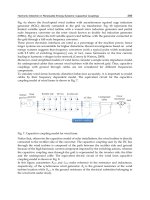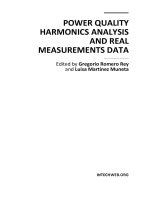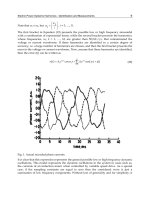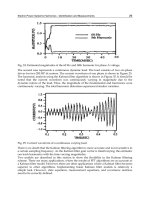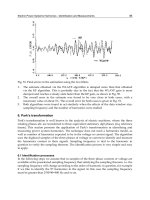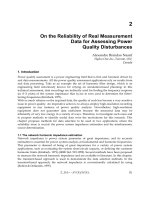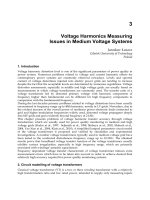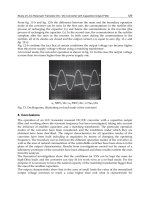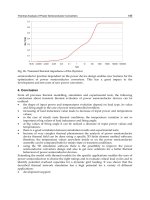Power Quality Monitoring Analysis and Enhancement Part 2 potx
Bạn đang xem bản rút gọn của tài liệu. Xem và tải ngay bản đầy đủ của tài liệu tại đây (572.72 KB, 25 trang )
Power Quality Monitoring
13
()
1
diag
dfv
−
=−V1Z Z1
(24)
where
1 is a matrix full of ones and such that its dimension is equal to the dimension of Z.
The square n × n matrix
V
dfv
contains the sags at each bus of the network due to faults at
each one of the buses. The during fault voltage at a general bus j when a fault occurs at that
bus is contained in the diagonal of
V
dfv
and is zero for a solid three phase fault. Off-diagonal
elements of
V
dfv
are the sags at a general bus k due to a fault at a general position f. Hence,
column f contains the during-fault voltages at buses 1, 2, …, f,…, n during the fault at bus f.
This means that the effect, in terms of sags, of a fault at a given bus of the system is
contained in columns of the voltage sag matrix. This information is usually presented on the
single line diagram of the power system and it is called affected area. A sample n ×n sag
matrix is shown as follows
12 1
22
21 2
11
12
11 22
01 1
101
11 0
n
nn
n
dfv
nn
nn
zz
zz
zz
V
zz
zz
zz
−−
−−
=
−−
(25)
In this chapter, a real sample network is used for description of the voltage sag matrix. Fig. 3
shows a 41-bus 230-kV of Tehran Regional Electric Company in Iran.
Fig. 3. Single line diagram of a 230 kV real case study
Power Quality – Monitoring, Analysis and Enhancement
14
Applying Equation (23), it is found the during fault voltages for the 41 buses due to the
faults on each one of the 41 buses. Equation (26) shows the resulting voltage sag matrix. It is
seen that column 34 of the sag matrix contains the during fault voltages at each one of the 41
buses when a three-phase fault occurs at bus 34. Column 34 of the sag matrix contains the
information to draw the affected area of the system due to a fault at bus 34.
1,2 1,34 1,41
2,2 34,34 41,41
2,1 2,34 2,41
1,1 34,34 41,41
34,1 34,2 34,41
1,1 2,2 41,41
41,1 41,2 41,34
1,1 2,2 34,34
01 1 1
101 1
11 0 1
11 1 0
dfv
zz z
zz z
zzz
zzz
V
zz z
zz z
zz z
zz z
−− −
−−−
=
−− −
−− −
(26)
Fig. 4. Affected areas for three-phase fault at buses 34 and 21
The affected area contains the load buses that present a during fault voltage lower than a
given value due to a fault at a given bus. In Fig. 4, three affected areas are presented for
Power Quality Monitoring
15
three-phase faults on the middle of the line 1-2 and the buses 21 and 34. The areas enclose
the load buses presenting a sag more severe than a retained voltage of 0.9 p.u. If the
threshold is less than 0.9, the areas are smaller than the areas shown in Fig. 4. Only the
original impedance matrix of positive sequence of the system is used to build the exposed
areas. Faults on lines are more frequent than fault on buses of the system, however faults on
buses cause more severe sags in terms of magnitude and therefore are considered for
building the affected areas. In the rest of this chapter, only faults on the buses are to be
considered.
The exposed area (area of vulnerability) is contained in rows of the voltage sag matrix and
as in the case of the affected area can be graphically presented on the single line diagram.
Fig. 5 presents the exposed area of bus 32. The exposed area encloses the buses and line
segments where faults cause a sag more severe than a given value. In Fig. 5, the 0.5 p.u.
exposed area of bus 32 contains buses 30 and 32. Similarly, the 0.8 pu exposed area for bus
32 contains all the buses where faults cause a retained voltage lower than 0.8 pu. Fig. 5
suggests that the exposed area is a closed set containing buses.
Fig. 5. Exposed area of bus 32 for three-phase faults
Unsymmetrical faults can also be considered to define the exposed area of a sensitive load.
Positive, negative, and zero sequence impedance matrices are needed to perform the
calculations.
To show the exposed areas for symmetrical and unsymmetrical faults, the exposed areas of a
three phase fault and a SLG fault at bus 35 are illustrated in Fig. 6. In this figure, the 0.8 pu
Power Quality – Monitoring, Analysis and Enhancement
16
SLG fault exposed area of bus 35 contains buses 30 and 32. Also, the 0.8 pu three phase fault
exposed area contains buses 30, 32, and 38. The SLG fault exposed area is almost coincident
with the three phase fault exposed area, however, a bit smaller.
Fig. 6. Exposed area of bus 35 for SLG and three-phase faults
It is noted that the exposed area is also the area for which a monitor, installed at a particular
bus k, is able to detect faults. For example, if a monitor is installed at bus 30 and the
boundary for sag recording is adjusted to 0.8 pu, then the monitor is be able to see the faults
in the 0.8 pu exposed area of bus 30. When referring to power quality monitors the exposed
area is called Monitor Reach Area (MRA). In the next section, the way of optimal locating of
the monitors is described to monitor all of the faults in the system.
8. Optimal placement of voltage sag monitors
In order to find optimal monitor locations for a monitoring program, the following two
premises are considered:
•
A minimum number of monitors should be used.
•
No essential data concerning the performance of load buses in terms of sags should be
missed.
The number of voltage sags recorded at a substation during a given monitoring time
depends upon the critical threshold setting of the power quality monitor. It is considered the
threshold level as the voltage p in pu at which the monitor starts recording. If the threshold
is set too low (e.g., 0.5 pu), then the monitor do not capture an important number of
disturbances. On the other extreme, if the threshold (p) is set high (e.g., 0.9 pu or higher)
Power Quality Monitoring
17
then the number of voltage sags recorded are excessive and even exceed the storage
capability of the monitor. This increase or decrease in the number of events captured can
be explained from the growth of the exposed area with increasing sensitivity of the
monitor.
The MRA is defined as the area of the network that is observed from a given monitor
position. The exposed area of a bus k is exactly the monitor reach area of a monitor installed
at that bus. The ability of the monitor to sense the remote faults is determined by the voltage
threshold setting p. The MRA is greater for small voltage changes than for big ones. In other
words, one monitor is theoretically able to capture all faults in the network for p equal to 1
pu. Similarly, only solid faults occurring at the monitor position is seen for a threshold p
equal to 0 pu.
8.1 Monitor Reach Area (MRA)
The part of the network that is observed by a monitor installed at bus k is thought as an area
containing bus k and its electrical neighbourhood. The size of this area depends mainly
upon the value of the voltage threshold of the monitor (p). This area is called
MRA
p
for bus
k.
MRA
p
is the area of the transmission network, surrounding the monitor position k, for
which the monitor is able to capture voltage drops that result in a retained voltage less than
or equal to p pu.
The
MRA
p
of bus k is shown as a set of buses. The MRA
k,p
is the set containing the indices of
the buses within the
MRA
p
of bus k. Using the voltage sag matrix V
dfv
, MRA
k,p
is
determined as follows:
{
}
,
,1,,,,
subject to
kp
ki
ki i k n
vp k
==
≤∀
MRA
(27)
The MRA is easily determined from the rows of the voltage sag matrix. A given bus i is part
of the MRA of bus k if the voltage at bus k during a fault at bus i is lower than or equal to p
pu. Equation (27) allows describing all the monitor reach areas and for any voltage
threshold setting of the monitor.
An alternative method to describe the MRAs is by using a binary matrix. For a given voltage
threshold setting p, the MRAs are described through an n×n binary matrix in which a 1 in
entry (i, j) indicates that bus j belongs to the MRA of bus i. Equation (28) shows this matrix,
where v
ij
is the (i, j) entry of the voltage sag matrix.
1
,
0
ij
pij
ij
if v p
mra i j
if v p
≤
== ∀
>
MRA
(28)
Once the MRAs for all possible locations are determined the optimization problem is
formulated to locate the optimum number of the monitors.
8.2 Optimization problem
Consider a binary variable row vector X of length n indicating if a monitor is needed at bus
i. Each element of X, x
i
, is indicated as follows
Power Quality – Monitoring, Analysis and Enhancement
18
1ifmonitoratbus
0otherwise
i
i
xi
=∀
(29)
The vector X is called Monitor Position Vector (MPV). A given combination of ones and
zeros indicates where to install the monitors as expressed in Equation (29).
Fig. 7. Optimal Monitors Emplacements
It is noted that for a given value of the MPV the product of X by the MRA
p
matrix indicates
the number of MRAs that contain each one of the buses
i. In order to satisfy the second
premise, this product should be greater than or equal to 1 for each bus; meaning that each
bus should be in at least one monitor reach area. Let
b be a row vector containing ones. The
Objective Function (
OF) of the optimization problem is formulated as follows
1
1
min
subject to
,1,2,,
n
i
i
n
iiji
i
OF x
xmra b j n
=
=
=
≥=
(30)
Where
x
i
is the binary decision variable indicating the need for a monitor at bus i; n is the
number of potential monitor positions. The right hand side, vector
b, defines the level of
Power Quality Monitoring
19
redundancy of the monitoring program. A particular value of b
i
indicates that a fault at the
fault position i trigger at least b
i
monitors. The level of redundancy of the monitoring
program is the minimum number of monitors that is guaranteed to trigger on the occurrence
of a fault. The letter T over MRA
p
indicates transposition of the MRA matrix for voltage
threshold
p.
The voltage sag matrix can be used instead of the MRA
p
matrix to formulate the
optimization problem. This option allows modelling different voltage threshold setting for
the monitors. The problem described by Equation (30) is an integer programming
optimization problem. A number of algorithms, e.g. Branch and bound Algorithm (BBA)
and Genetic Algorithm (GA), have been proposed for solving this type of problem.
As an example, the optimization method is applied to the sample network of Fig. 3. The
BBA algorithm is used to solve the optimization problem. Let the voltage threshold
p of the
monitors equals to 0.9pu. If all of the faults are considered to be three phase faults, the
results of the optimization show that the monitors should be installed at the buses 1, 22, 26,
29, and 38. It is clear that the number of monitors needed to cover the whole system
increases with the decrease of the monitor threshold. Fig. 7 shows the optimal monitors
emplacements and their reach area.
In Fig. 7, letter M shows the monitor places. The dashed lines also show the reach area of
each of the monitors.
9. Conclusion
Power quality monitoring is necessary to characterize electromagnetic phenomena at a
particular location on an electric power circuit. In this chapter, the monitoring of voltage sag
which is one of the most important power quality phenomena has been discussed. The
voltage sag magnitude has been monitored to find the origin of the voltage sag and detect
all of the sags in the system.
Voltage sags are determined by fault types, fault impedances, and etc. With respect to the
fault type, the shape of the rms voltage evolution shows different behavior. The calculations
of all types of faults which may cause the sags have also been discussed in this chapter.
Ideally, a full monitoring program can be used to characterize the performance of entire
system, i.e. every load bus should be monitored. Such a monitoring program is not
economically justifiable and only a limited set of buses can be chosen for a monitoring
program. This has led to the optimal monitoring program which has been proposed in this
chapter.
10. References
Baggini, A. (2008). Handbook of Power Quality, Wiley-IEEE Press, ISBN 978-0-470-06561-7,
John Wiley & Sons Ltd, West Sussex, England
Bollen, M.H.J. (1999).
Understating Power Quality Problems: Voltage Sags and Interruptions,
Wiley-IEEE Press, ISBN 978-0-7803-4713-7, New-York, USA
Casarotto, C. & Gomez, J.C. (2009). Calculation of Voltage Sags Originated in Transmission
Systems Using Symmetrical Components,
Proceedings of the 20
th
International
Conference on Electricity Distribution (CIRED)
, Parague, June 8-11, 2009
Power Quality – Monitoring, Analysis and Enhancement
20
Gerivani, Y. ; Askarian Abyaneh, H. & Mazlumi, K. (2007). An Efficient Determination of
Voltage Sags from Optimal Monitoring, Proceedings of the 19
th
International
Conference on Electricity Distribution (CIRED)
, Vienna, Austria, May 21-24, 2007
Grigsby, L.L. (2001).
The Electric Power Engineering Handbook, CRC Press, ISBN 978-1-4200-
3677-0, Florida, USA
Mazlumi, K.; Askarian Abyaneh, H. ; Gerivani, Y. & Pordanjani, I.R. (2007). A New Optimal
Meter Placement Method for Obtaining a Transmission System Indices,
Proceedings
of Power Tech 2007 conference, pp. 1165-1169, Lausanne, Switzerland, July 1-5, 2007
Milanovic, J.V.; Aung, M.T. & Gupta, C.P. (2005). The Influence of Fault Distribution on
Stochastic Prediction of Voltage Sags.
IEEE Transactions on Power Delivery, Vol.20,
No.1, (January 2005), pp. 278-285
Moschakis, M.N. & Hatziargyriou, N.D. (2006). Analytical Calculation and Stochastic
Assessment of Voltage Sags.
IEEE Transactions on Power Delivery, Vol.21, No.3, (July
2006), pp. 1727-1734
Olguin, G. & Bollen, M.H.J. (2002). Stochastic Prediction of Voltage Sags: an Overview,
Proceedings of Probabilistic Methods Applied to Power Systems Conference, Naples, Italy,
September 22-26, 2002
Olguin, G. (2005).
Voltage Dip (Sag) Estimation in Power Systems based on Stochastic Assessment
and Optimal Monitoring,
Ph.D. Thesis, Chalmers University of Technology,
Göteborg, Sweden
Olguin, G.; Bollen, M.H.J. (2002). The Method of Fault Position for Stochastic Prediction of
Voltage Sags: A Case Study,
Proceedings of Probabilistic Methods Applied to Power
Systems Conference
, Naples, Italy, september 22-26, 2002
Salim, F. & Nor, K.M. (2008). Optimal voltage sag monitor locations,
Proceedings of the
Australasian Universities Power Engineering Conference (AUPEC '08)
, Sydney,
Australia, December 14-17, 2008
2
Wavelet and PCA to Power Quality Disturbance
Classification Applying a RBF Network
Giovani G. Pozzebon¹, Ricardo Q. Machado¹, Natanael R. Gomes²,
Luciane N. Canha² and Alexandre Barin²
¹São Carlos School of Engineering, Department of Electrical Engineering,
University of São Paulo
²Federal University of Santa Maria
Brazil
1. Introduction
The quality of electric power became an important issue for the electric utility companies
and their customers. It is often synonymous with voltage quality since electrical equipments
are designed to operate within a certain range of supply specifications. For instance, current
microelectronic devices are very sensitive to subtle changes in power quality, which can be
represented as a disturbance-induced variation of voltage amplitude, frequency and phase
(Dugan et al., 2003).
Poor power quality (PQ) is usually caused by power line disturbances such as transients,
notches, voltage sags and swells, flicker, interruptions, and harmonic distortions (IEEE Std.
1159, 2009). In order to improve electric power quality, the sources and causes of such
disturbances must be known. Therefore, the monitoring equipment needs to firstly and
accurately detect and identify the disturbance types (Santoso et al., 1996). Thus, the use of
new and powerful tools of signal analysis have enabled the development of additional
methods to accurately characterize and identify several kinds of power quality disturbances
(Karimi et al., 2000; Mokhtary et al., 2002).
Santoso et al. proposed a recognition scheme that is carried out in the wavelet domain using
a set of multiple neural networks. The network outcomes are then integrated by using
decision-making schemes such as a simple voting scheme or the Dempster-Shafer theory.
The proposed classifier is capable of providing a degree of belief for the identified
disturbance waveform (Santoso et al., 2000a, 2000b). A novel classification method using a
rule-based method and wavelet packet-based hidden Markov models (HMM) was proposed
bay Chung et al. The rule-based method is used to classify the time-characterized-feature
disturbance and the wavelet packet-based on HMM is used for frequency-characterized-
feature power disturbances (Chung et al., 2002). Gaing presented a prototype of wavelet-
based network classifier for recognizing power quality disturbances. The multiresolution-
analysis technique of discrete wavelet transforms (DWT) and Parseval’s theorem are used to
extract the energy distribution features of distorted signals at different resolution levels.
Then, the probabilistic neural network classifies these extracted features of disturbance type
identification according to the transient duration and energy features (Gaing, 2004). Zhu et
Power Quality – Monitoring, Analysis and Enhancement
22
al. proposed an extended wavelet-based fuzzy reasoning approach for power quality
disturbance recognition and classification. The energy distribution of the wavelet part in
each decomposition level is calculated. Based on this idea, basic rules are generated for the
extended fuzzy reasoning. Then, the disturbance waveforms are classified (Zhu et al., 2004).
Further on, Chen and Zhu presented a review of the wavelet transform approach used in
power quality processing. Moreover, a new approach to combine the wavelet transform and
a rank correlation is introduced as an alternative method to identify capacitor-switching
transients (Chen & Zhu, 2007).
Taking into account these ideas, this chapter proposes the application of a different method
of power quality disturbance classification by combining discrete wavelet transform (DWT),
principal component analysis (PCA) and an artificial neural network in order to classify
power quality disturbances. The method proposes to analyze seven classes of signals,
namely Sinusoidal Waveform, Capacitor Switching Transient, Flicker, Harmonics,
Interruption, Notching and Sag, which is composed by four main stages: (1) signal analysis
using the DWT; (2) feature extraction; (3) data reduction using PCA; (4) classification using a
radial basis function network (RBF). The MRA technique of DWT is employed to extract the
discriminating features of distorted signals at different resolution levels. Subsequently, the
PCA is used to condense information of a correlated set of variables into a few variables,
and a RBF network is employed to classify the disturbance types.
2. Proposed classification scheme
Si
g
nal
Wavelet
Transform
Feature vector
PCA
RBF
T
y
pe of
Disturbance
9
c
μ
j
d
σ
12 9
d,d, ,d⋅⋅⋅
9
c
110⋅⋅⋅⋅⋅
⋅⋅⋅⋅⋅
Fig. 1. Diagram of the proposed classification scheme
This section presents the mainframe of the scheme proposed in this paper using the wavelet
transform, principal components and neural networks to classify PQ disturbances. The
Wavelet and PCA to Power Quality Disturbance Classification Applying a RBF Network
23
proposed scheme diagram is shown in Fig. 1. Initially, the input signals are analyzed using
the discrete wavelet transform tool, which employs two sets of functions called scaling
functions and wavelet functions associated with low pass and high pass filters, respectively.
Then, the signal is decomposed into different resolution levels aiming to discriminate the
signal disturbances. The output of the DWT stage is used as the input to the feature extraction
stage, on which the featuring signal vectors are built. In order to reduce the amount of data,
the PCA technique is applied to the feature vector in order to concentrate the information from
the disturbance signal and to reduce the amount of the training data used, consequently
minimizing the number of input RBF neurons while maintaining the recognition accuracy.
Finally, an RBF network is employed to perform the disturbance type classification.
As aforementioned, in the introduction, this work proposes to analyze seven classes of
different types of PQ disturbances as follows: Pure sine (C
1
); Capacitor switching (C
2
);
Flicker (C
3
); Harmonics (C
4
); Interruption (C
5
); Notching (C
6
); Sag (C
7
). The databases used
for training and evaluation of the proposed system and classification algorithms were
performed in Matlab
®
. The tools used in this approach are presented in sequence.
2.1 The wavelet transform and multiresolution analysis
The DWT is a versatile signal processing tool that has many engineering and scientific
applications (Barmada et al., 2003). One area in which the DWT has been particularly
successful is transient analysis in power systems (Santoso et al., 2000a, 2000b; Yilmaz et al.,
2007), used to capture the transient features and to accurately localize them in both time and
frequency contexts. The wavelet transform is particularly effective in representing various
aspects of non-stationary signals such as trends, discontinuities and repeated patterns, in
which other signal processing approaches fail or are not as effective. Through wavelet
decomposition, transient features are accurately captured and localized in both time and
frequency contexts.
A wavelet is an effective time–frequency analysis tool to detect transient signals. Its features
of extraction and representation properties can be used to identify various transient events
in power signals. The discrete wavelet transform analyzes the signal at different frequency
bands with different resolutions by decomposing the signal into a coarse approximation and
detail information (Chen & Zhu, 2007). This capability to expand function or signal with
different resolutions is termed as Multiresolution Analysis (MRA) (Mallat, 1989). The DWT
employs two sets of functions called scaling functions,
j,n
[t]
φ
, and wavelet functions,
j,n
[t]
ψ
,
which are associated with low-pass and high-pass filters, respectively. The decomposition of
the signal into the different frequency bands is simply obtained by successive high-pass and
low-pass filtering of the time domain signal. The discrete forms of scale and wavelet
functions are, respectively, defined as follows.
j
j
2
j,n j,n
n
[t] 2 c [2 t n]
φ
=
φ
−
(1)
j
j
2
j,n j,n
n
[t] 2 d [2 t n]
ψ
=
ψ
−
(2)
Where
j
c and
j
d are the scaling and wavelet coefficients indexed by j, and both functions
must be orthonormal.
Power Quality – Monitoring, Analysis and Enhancement
24
The wavelet and scaling functions are used to perform simultaneously a multiresolution
analysis decomposition and reconstruction of the signal. The former can decompose the
original signal in several other signals at different resolution levels. From these decomposed
signals, the original signal can be recovered without losing any information. Therefore, in
power quality disturbance signals, the MRA technique discriminates the disturbances from
original signals, and then they can be analyzed separately (Debnath, 2002). The recursive
mathematical representation of MRA is as follows:
jj
1
j
1
j
1
j
2
j
nn
VW V W W W V
++ + + +
=⊕=⊕⊕⋅⋅⋅⊕⊕
(3)
Where:
j
1
V
+
is the approximate version of a given signal at scale j+1;
j
1
W
+
is the detailed
version displaying all transient phenomena of the given signal at scale j+1; symbol
⊕
denotes an orthogonal summation; and n represents the decomposition level.
Since
j
,n
j
W
ψ
∈ it follows immediately that
j
,n
ψ
is orthonormal to
j
,n
φ
because all
j
,n
φ
∈
j
V
are
jj
VW⊥ . Also, because all
j
V are mutually orthogonal, it follows that the wavelets are
orthonormal across scaling. A detailed approach about this theory can be found in (Mallat,
1989; Strang & Nguyen, 1997; Debnath, 2002).
From the engineering point of view, DWT is a digital filtering process in the time domain,
by discrete convolution, using the analyses Finite-Impulse-Response (FIR) filters h and g,
followed by a down sampling of two. The filter g(k) can generate a detailed version of the
signal, while h(k) produces an approximate version of the signal. In the DWT, the resulting
coefficients from the low-pass filtering process can be processed again as entrance data for a
subsequent bank of filters, generating another group of approximation and detail
coefficients.
The schematic diagram in Fig. 2 shows two decomposed levels of DWT. The input signal f(t)
is split into the approximation
j
,k
c and the detail
j
,k
d by a low-pass and a high-pass filters
named h(k) and g(k), respectively. Both, output approximation and detail are decimated by
2. In a practical approach, a DWT depends on:
• the original signal, f(t);
• the low-pass filter, h(k), used;
• the high-pass filter, g(k), used.
f(t)
h(k)
g
(k)
2
2
2
2
1,k
c
h(k)
g
(k)
2,k
c
1,k
d
2,k
d
f(t)
freq
0
4
→
f(t) f(t)
freq freq
42
→
f(t) f(t)
freq freq
84
→
f(t)
freq
0
8
→
Fig. 2. Decomposition of
f(t) into 2 scales
Wavelet and PCA to Power Quality Disturbance Classification Applying a RBF Network
25
There are several families of wavelet functions which contain filters of several supports
(filter size). However, in this application, as in (Zhu et al., 2004; Chen & Zhu, 2007), the
Daubechie “db4” wavelet was adopted to perform the DWT. As can be seen in (Daubechies,
1992), the “db4” is a wavelet of support four, i.e., each filter has four coefficients,
0123
hhhhh=
. The analysis filter h is always the QMF (quadrature mirror filter)
pair of g. Therefore, from the high-pass filter g the low-pass filter h is obtained, inverting
the order and putting the negative sign alternately as follows,
3210
g
hhhh=− −
.
The coefficients of the “db4” wavelet filters, h and g are presented as follows (Daubechies,
1992).
13333313
h
42 42 42 42
++−−
=
(4)
13 3333 13
g
42 42 42 42
−−+ +−−
=
(5)
In practice, the previous filters are the only elements required to calculate the DWT of any
signal. As previously mentioned, it is a digital filtering process in the time domain by
discrete convolution. In (6) and (7) the relations from the level c
j
to the next level, c
j+1
and
d
j+1
are given. This relation involves the filters h and g. For specific filter, these equations
allow to find the wavelet coefficients using samples of the signal f(t), once the samples are
the initial coefficients c
j
(Mix & Olejniczak, 2003).
j1 j
n
c (k) h(n 2k)c (n)
+
=−
(6)
j1 j
n
d(k)
g
(n 2k)c (n)
+
=−
(7)
Approximation and detail coefficients are down-sampled by 2 in each decomposition level.
According to the Nyquist theorem cited in (Mallat, 1989), the maximum frequency of an
original signal f(t) sampled at freq
f(t)
Hz is (freq
f(t)
/2) Hz. Therefore, the maximum
frequencies freq
Level
of signals c
j
and d
j
at each resolution level, are given by (8), where freq
s
is the sampling frequency.
s
Level
Level
freq
freq
2
=
(8)
The sampling frequency and amplitude for all types of disturbances considered in this
approach are 15.36 kHz (256 samples per period – fundamental frequency of 60 Hz) and 1
p.u., respectively. The wavelet transform is applied to perform a 9-level decomposition of
each discrete disturbance signal to obtain the detailed version coefficients (d
1
– d
9
), and the
approximated version coefficient (c
9
). In this experiment, the adopted frequency bandwidths
at each decomposition level are shown in Table 1.
Following, it is presented an example of a simple algorithm in MatLab
®
to demonstrate how
the DWT is applied in practice (Mix & Olejniczak, 2003).
Power Quality – Monitoring, Analysis and Enhancement
26
% with f as the original signal; N the length of f; and g and h the wavelet filters:
%
for one decomposition level, the following is done:
f0=conv(g,f); %
convolution of g with f.
f1=conv(h,f); %
convolution of h with f.
f0=f0(1,2:N+1); %
eliminate first value.
f1=f1(1,2:N+1);
f0=reshape(f0,2,N/2); %
down sampling.
f1=reshape(f1,2,N/2);
c1=f0(1,:); %
the output c of length N/2.
d1=f1(1,:); %
the output d of length N/2.
This example code produces decomposed signals (c
1
and d
1
) at level 1, which are the
approximated and detailed version of the original signal f, respectively. In this example the
signal f contains N samples, but the two derived signals c
1
and d
1
contain N/2 samples due
to down-sampling.
Level Parameter Frequency band (Hz) Harmonics included
9 c
9,k
0 – 15 -
9 d
9,k
15 – 30 -
8 d
8,k
30 – 60 1st
7 d
7,k
60 – 120 1st – 2nd
6 d
6,k
120 – 240 2nd – 4th
5 d
5,k
240 – 480 4th – 8th
4 d
4,k
480 – 960 8th – 16th
3 d
3,k
960 – 1920 16th – 32th
2 d
2,k
1920 – 3840 32th – 64th
1 d
1,k
3840 – 7680 64th – 128th
Table 1. Scale to Frequency Range Conversion Based on 60 Hz Power Frequency
0 0.05 0.1 0.15 0.2 0.25
-1
0
1
V(pu)
0 0.05 0.1 0.15 0.2 0.25
-0.2
0
0.2
d1
0 0.05 0.1 0.15 0.2 0.25
-0.2
0
0.2
d3
0 0.05 0.1 0.15 0.2 0.25
-0.5
0
0.5
Time (s)
d5
Fig. 3. The voltage interruption signal and detail coefficients: first decomposed level (d1),
third decomposed level (d3), and fifth decomposed level (d5)
Wavelet and PCA to Power Quality Disturbance Classification Applying a RBF Network
27
Figures 3, 4 and 5 show the decomposition plots of the signals using the “db4” wavelet. An
example of interruption disturbance and the detail coefficients d1, d3 and d5 are shown in
Fig. 3. Fig. 4 shows an oscillatory transient disturbance due to a capacitor switching
transient, and detail coefficients d1, d2 and d3, respectively. Fig. 5 depicts a sag disturbance
and detail coefficients d1, d3 and d5, respectively.
0 0.05 0.1 0.15 0.2 0.25
-1
0
1
V(pu)
0 0.05 0.1 0.15 0.2 0.25
-1
0
1
d1
0 0.05 0.1 0.15 0.2 0.25
-1
0
1
d2
0 0.05 0.1 0.15 0.2 0.25
-0.5
0
0.5
Time (s)
d3
Fig. 4. The capacitor switching signal and detail coefficients: first decomposed level (d1),
second decomposed level (d2), and third decomposed level (d3)
0 0.05 0.1 0.15 0.2 0.25
-1
0
1
V(pu)
0 0.05 0.1 0.15 0.2 0.25
-0.02
0
0.02
d1
0 0.05 0.1 0.15 0.2 0.25
-0.1
0
0.1
d3
0 0.05 0.1 0.15 0.2 0.25
-0.5
0
0.5
Time (s)
d5
Fig. 5. The voltage sag and detail coefficients: first decomposed level (d1), third decomposed
level (d3), and fifth decomposed level (d5)
2.2 Feature extraction
Using the DWT technique to analyze a signal through the level of MRA will generate severe
variation in coefficients d
j.
Therefore, applying the standard deviation at different resolution
Power Quality – Monitoring, Analysis and Enhancement
28
levels one can quantify the variation magnitude of the signals (Oleskovicz et al., 2006;
Kanitpanyacharoean & Premrudeepreechacharn, 2004). The standard deviation is defined as
in (9).
n
2
i
i1
X
(X X)
n1
=
−
σ=
−
(9)
where
i
X represents the detail coefficient data; X is the data average; and n is the amount
of data.
Figure 6 shows a comparison of the two standard deviation curves along the 9
decomposition levels. One of these curves is from the analysis of a signal containing a sag
disturbance, and the other curve is from a sinusoidal waveform analysis. By observing Fig. 6
one can notice there was a decrease in the coefficients of the 8
th
decomposition level, which
concentrates most of the fundamental frequency components. While Fig. 7 shows the
standard deviation curve of the detail coefficients from MRA analysis of an oscillatory
transient signal caused by capacitor switching compared with a pure sinusoidal analysis.
Differently from Fig. 6, which presents variations at the 8 level, Fig. 7 displays variations at
the 3 and 4 levels, which concentrate high frequencies.
0 1 2 3 4 5 6 7 8 9 10
0
2
4
6
8
Decomposition level
Standard deviation
Event
Sinusoidal
Fig. 6. Standard deviation curves – sag disturbance analysis compared with a sinusoidal
waveform analysis
Several simulation tests were performed in order to determine the number of levels, hence
reaching better results with 9 decomposition levels. With a lower number of levels some
important features can be suppressed at lower frequencies. On the other hand, a higher
number of levels can generate non-representative features since there is not sufficient
information at the last levels due to the number of signal data considered in this paper.
Additionally, in order to take into account these features that originated from the low
frequency components (smaller than 60 Hz), this paper includes the approximated version,
c
9
, of the original disturbance signal f(t). Experimentally, better results were obtained when
using the mean of c
9
rather then the standard deviation. The average of data is defined by (10).
Wavelet and PCA to Power Quality Disturbance Classification Applying a RBF Network
29
n
Xi
i1
1
X
n
=
μ=
(10)
where
i
X represents the approximate coefficients and n is the total of data.
The features extracted from the standard deviation and the average value will compound
the feature vector,
12 LL
T
dd dc
=σ σ σ μ
x
, of each signal, where L is the number of
MRA levels.
0 1 2 3 4 5 6 7 8 9 10
0
2
4
6
8
Decomposition level
Stamdard deviation
Event
Sinusoidal
Fig. 7. Standard deviation curves – oscillatory transient disturbance analysis compared with
a sinusoidal waveform analysis
2.3 Principal component analysis
The principal component analysis is a statistical technique whose purpose is to condense
information from a large set of correlated variables into fewer variables (“principal
components”), while preserving the variability that is in the data set (Jolliffe, 2002). Each
component contains new information about the data set, and it is ordered in such a way that
the first few components account for most of the variability.
The PCA transforms a random vector
m
∈x
into another vector
n
∈y (for n m)≤ ,
projecting
x into n orthogonal directions with more variance. Generally, most of the data
variance is explained by a reduced number of components, so it is possible to reject other
components without losing relevant information.
Let
12 M
NM
×
=
Xxx x be a matrix formed by M feature vectors x , previously
defined, where
1
x ,
2
x ,
M
,x are the M observation disturbance signals, and N=10 is the
dimension of each feature vector. As in (Jolliffe, 2002; Castells et al., 2007), derivation of the
principal components is based on the assumption that
x is a random process characterized
by the correlation matrix
x
E[ ]=
T
Rxx. Then, the principal components of x are obtained
from the application of an orthonormal linear transformation [ ]
12 Ν
=ϕϕ ϕΦ to x ,
T
w=Φ x ,
(11)
Power Quality – Monitoring, Analysis and Enhancement
30
so that, the elements of the principal component vector
T
12 N
ww w=
w become
mutually uncorrelated. The first principal component is obtained as a scalar product
T
11
w =
ϕ
x , where vector
1
ϕ
is chosen so that the variance of
1
w, is
2T T
11111
E[w ] E[ ]=ϕ ϕ=ϕ ϕ
T
x
xx R ,
(12)
maximally subject to the constraint
T
11
1
ϕϕ
= . The maximal variance is obtained when
1
ϕ
is
the normalized eigenvector corresponding to the largest eigenvalue of
x
R , denoted by
1
λ .
The resulting variance is:
2T T
1111111
E[w ] =
ϕϕ
=λ
ϕϕ
=λ
x
R ,
(13)
The second principal component
2
w is obtained by choosing
2
ϕ
as the eigenvector
corresponding to the second largest eigenvalue of
x
R , and so on until the variance of x is
completely represented by
w. Hence, to obtain the whole set of N different principal
components, the eigenvector equation for
x
R needs to be solved, according to (14).
=
x
R ΦΦΛ,
(14)
where
Λ
denotes a diagonal matrix with the eigenvalues
1N
,,λλ . Since
x
R is rarely
known in practice, the N N
× sample correlation matrix, is defined by
1
ˆ
M
=
T
x
RXX,
(15)
replacing
x
R when the eigenvectors are calculated in (13).
As previously mentioned, to obtain the principal components, it is necessary to calculate the
eigenvalues and eigenvectors of
ˆ
x
R , which is the covariance matrix of the N M× data
matrix
X . Therefore, once matrix Φ is known it is possible to calculate the principal
components. In this experiment, the 4 first principal components were adopted, which are
123
w,w,w and
4
w , since their contributions correspond to more than 90% of the data
variability, i.e.,
P
90%
β
> , defined according to (16) as
P
k
k1
P
N
k
k1
100%
=
=
λ
β=
λ
,
(16)
where
k
λ are the eigenvalues of
ˆ
x
R , N 10= and P4= .
Note that the PCA result is a set of independent elements that could be used as an
orthonormal basis to approximate the original feature set extracted from the analyzed
signals. It is possible, through a linear combination of such components, to generate those
features used to characterize the analyzed signals. In this paper, the contributions of the first
4 principal components, resulting from the PCA technique, is 97.72% as the canonical
weights to feature vectors in the training data set. Fig. 8 shows the principal components
and their respective percentage of variances.
Wavelet and PCA to Power Quality Disturbance Classification Applying a RBF Network
31
1 2 3 4 5 6 7 8 9 10
0
10
20
30
40
50
60
Principal component
Variance explained (%)
Fig. 8. Variance explained by principal components
The
W
matrix containing the principal components is applied to perform a new data set to
represent each disturbance signal. These new set is calculated as in (17).
T
NP NM
××
=YW X ,
(17)
where
NM×
X is the original data matrix, and
NP×
W is a matrix containing the
P
first
components. Hence,
Y
is a P N× matrix representing a new uncorrelated data set.
2.4 The radial basis function network
The PQ disturbances classification is the last stage of the algorithm. In order to execute such
classifications this paper proposes a radial-basis function (RBF) network. The classifications
are performed by the RBF into two ways: one by not applying PCA algorithm and the other
applying PCA algorithm so as to validate this proposed method.
1
x
2
x
N
x
1
2
1
N
1
2
N
(j)
1
w
(j)
2
w
1
μ
2
μ
1
N
μ
0
1
μ
=−
0
1
μ
=−
1
y
2
N
y
Input
La
y
er
Hidden
La
y
er
Output
La
y
er
Fig. 9. A typical radial basis function network
Power Quality – Monitoring, Analysis and Enhancement
32
Construction of a RBF network, in its most basic form, involves three layers with entirely
different roles. The input layer is made up of source nodes connecting the network to its
environment. The second layer, the only hidden layer in the network, applies a nonlinear
transformation from the input layer space to the hidden layer space; in most applications the
hidden space is of high dimensionality. The output layer is linear, supplying the network
response to the activation pattern (signal) applied to the input layer (Fyfe, 1996). In other
words, the hidden neuronal function forms a basis for the input vectors and output neurons
merely by calculating a linear combination of the hidden neuron’s output. A typical RBF
network is shown in Fig. 9.
In pattern classification problems, the separation of classes in the RBF is accomplished with
radial-basis functions. The maximum distance criteria are specified so as to obtain the
classification. An often-used set of basis functions is the Gaussian functions whose mean
and variance may be determined to a certain degree by the input data (Haykin, 1998).
2.4.1 The RBF training process
The RBF training consists of two stages, i.e., the hidden layer training process followed by
the output layer training process. The RBF configuration for both classification procedures is
as follows.
•
Neurons at the input layer: feature vector lengths (4 or 10).
•
Neurons at the hidden layer: 45.
•
Neurons at the output layer: 7.
•
Output learning rate: 10
-4
.
•
Output accuracy: 10
-8
.
For the hidden layer training a non-supervised method was used, i.e., a typical grouping
algorithm. The objective is to adjust the center of each Gaussian function in areas of input
vectors tending to form groups. This procedure can be done by means of vector
quantization using the “K-means” algorithm (Tou & Gonzalez, 1974; Haykin, 1998).
Training the output layer was only executed after of the function base parameters executed
in the previous stage were determined. The training group of the output layer is formed by
input/output pairs
{
}
(k), d(k)μ , whose vectors are specified after training the first layer.
The output layer was trained using the “generalized delta rule” algorithm, which adjusts the
network weights minimizing the quadratic error between
(k)μ
and
d(k)
(Haykin, 1998).
The Gaussian function usually used as an activation function for neurons of the hidden
layer has the following form:
()()
T
(j) (j)
1
1
j
2
j
x(k) w x(k) w
exp
2
−−
μ= −
σ
,
(18)
where
1
j
1N= are the inputs,
(
j
)
1
w are the synaptic weights connecting the input layer to
the hidden layer, and
2
j
σ
are the variances between
x(k) and
(
j
)
1
w calculated during the
training of the hidden layer. Then, the maximum answer of each neuron should happen
when
x(k) is very close to
(
j
)
1
w . The answer decreases as x(k) moves away from
(
j
)
1
w ,
making the Gaussian cone narrower, as the variance
2
j
σ
becomes smaller. Additionally,
these cones have an identical output for inputs that are at a fixed distance of the Gaussian
Wavelet and PCA to Power Quality Disturbance Classification Applying a RBF Network
33
function center. Finally, the outputs
j
y
of the exit layer neurons were obtained in the
following way:
11
NN
j
2
j
ii 2
j
ii
i0 i0
yg w w
==
=
μ
=
μ
,
(19)
where
1
j
1N= ,
j
y
is the output of the j
th
neuron of the output layer,
2
j
i
w is the synaptic
weights matrix of the second layer,
g
()⋅ is the linear function activation, and
i
μ
is the
output value of the i
th
neuron of the first neural layer (added by the threshold), being
0
1
μ
=− .
3. Computational results
The classification results are presented in this section and the proposed method using the
PCA algorithm is evaluated by considering two situations. Firstly, the RBF training and the
PQ disturbance classification was performed without using the PCA algorithm. Then, in the
second situation, the PCA algorithm was applied to perform the RBF training and
classification. The processing time was obtained, as well as the number of training epochs, the
mean squared error (MSE) and the classification accuracies in both situations so as to
compare the proposed classification performance. Table 2 shows an overview of the RBF’s
computational performance obtained in the training and classification procedures. Table 3
shows the classification results of the first situation when the classification process was
performed without using the PCA. The classification results with the PCA are shown in Table
4. In this situation the feature vector dimension was reduced, preserving those features with
more variability, as presented in section II. In both tables each row represents a disturbance
to be classified and each column shows which category that disturbance was classified in.
PCA Without PCA
Neurons at the input layer 4 10
Training epochs 48385 49065
Mean squared error 0.1223 0.1276
Training time 243.3
s 203.5 s
Classification time 44.9
ms 45.0 ms
Table 2. RBF classification performances
C
1
C
2
C
3
C
4
C
5
C
6
C
7
(%)
Sinusoidal 25 0 0 0 0 0 0 100
Transient 0 25 0 0 0 0 0 100
Flicker 5 0 18 0 0 1 1 72
Harmonics 0 0 0 25 0 0 0 100
Interruption 0 0 0 0 23 0 2 92
Notching 2 0 0 0 0 23 0 92
Sag 1 0 0 0 1 0 23 92
Overall accuracy: 92.57 %
Table 3. Classification results using PCA algorithm
Power Quality – Monitoring, Analysis and Enhancement
34
C
1
C
2
C
3
C
4
C
5
C
6
C
7
(%)
Sinusoidal 25 0 0 0 0 0 0 100
Transient 2 23 0 0 0 0 0 92
Flicker 6 1 16 0 0 1 1 64
Harmonics 0 0 0 25 0 0 0 100
Interruption 0 0 0 0 23 0 2 92
Notching 2 0 0 0 0 23 0 92
Sag 1 0 0 0 1 0 23 92
Overall accuracy: 90.29 %
Table 4. Classification results without using PCA algorithm
4. Final comments
The main goal of this approach is to accomplish classifications of PQ disturbances, which
are responsible for degrading the quality of electric power systems, by applying a RBF
network. To best adapt the PQ disturbance signals, several stages of preprocessing were
necessary. For instance, by applying the wavelet transform it was possible to analyze signals
at different ranges of frequencies and to maintain the time resolution. This makes wavelet
transformation a highly applicable tool in PQ analysis as broached in this paper. This is so
because several disturbances happen with different characteristics in time and frequency,
which are difficult to analyze with simple Fourier transform.
Among the several forms of analysis for the DWT coefficients, this paper proposes the
calculation of the standard deviation curve of details and the average of approximation
coefficients as a complement to this analysis. By observing Figs. 6 and 7, variations of the
decomposition levels are clearly observable according to the disturbance contained in the
signals.
The PCA tool has shown to be an effective and very interesting tool when it is applied to
the pre-processing classification. By applying the PCA it was possible to reduce the
amounts of data inserted into the RBF network, and it was also possible to choose which
data were more significant and best representative of the disturbances. Although with a
reduction of 60% in the feature vectors, the principal components could represent 97.72%
of the information that characterized the disturbances. In addition, the method using PCA
to perform a disturbance classification did not increase the processing time of the RBF
network, as shown in Table 2.
Finally, taking into account the amount of disturbance classes considered in this paper,
the classification results applying the proposed PCA method were better than those
obtained when PCA was not applied. Using the same RBF configuration, the classification
using PCA obtained 92.57% of success, while the classification not using PCA obtained
only 90.29%.
As shown in Table 3, three disturbance classes were classified with 100% of success. The
sinusoidal signals (without any type of disturbance), were inserted in the classification to
discriminate those signals containing disturbances from those without any disturbances.
Therefore, the signals containing some disturbance type were classified as not containing
disturbance. This can be due to a very low disturbance intensity, which might have
characterized the signals as pure sinusoidal signals.
Wavelet and PCA to Power Quality Disturbance Classification Applying a RBF Network
35
5. Conclusion
In this work, wavelet and neural network methodology was employed to extract features
and classify disturbance signals, respectively. Different from other works, which adopted
similar approaches; this paper is concerned in eliminating redundant information from the
feature space, therefore, reducing the number of input data and maintaining the processing
time. The PCA technique was used to reduce feature space dimension, allowing the
implementation of a neural network with a lower number of neurons, hence performing a
better classification process.
By comparing the classification results and processing time from two systems discussed in
this work, it was possible to demonstrate the validity of the PCA technique, which was able
to classify the disturbances with an average accuracy of 92.57%.
6. Acknowledgment
The authors thank the administrative-office team of the São Carlos School of Electrical
Engineering at the University of São Paulo, the authors are also very grateful to FAPESP,
CAPES and the Post-Graduation Program in Electrical Engineering at the Federal University
of Santa Maria.
7. References
Barmada, S., Landi, A., Papi, M. & Sani, L. (2003). Wavelet multiresolution analysis for
monitoring the occurrence of arcing on overhead electrified railways,
Journal
Proceedings of the Institution of Mechanical Engineers, Part F: Journal of Rail and Rapid
Transit
, Vol.217, No.3, (2003), pp.(177-187), ISSN 2041-3017.
Castells, F., Laguna, P., Bollmann, A. & Roig, J. M. (2007). Principal component analysis in
ECG signal processing,
EURASIP Journal on Advances in Signal Processing, Vol.2007,
No.1, (January 2007), pp. (98-98), ISSN 1110-8657.
Chen, S. & Zhu, H. Y. (2007). Wavelet transform for processing power quality disturbances,
EURASIP Journal on Advances in Signal Processing, Vol.2007, No.1, (January 2007),
pp. (176-176), ISSN 1110-8657.
Chung, J., Powers, E. J., Grady, W. M. & Bhatt, S. C. (2002). Power disturbance classifier using a
rule-based method and wavelet packet-based hidden markov model,
IEEE Transaction
on Power Delivery,
Vol.17, No.1, (January 2002), pp. (233–241), ISSN 0885-8977.
Daubechies, I. (1992).
Ten Lectures on wavelet, Society for Industrial and Applied
Mathematics (SIAM), ISBN 0-89871-274-2, Philadelphia, PA, USA.
Daubechies, I. (1996). Where Wavelets Come From? – A Personal Point of View,
Proceedings
of the IEEE, Vol.84, No.4, (April 1996), pp. (510-513), ISSN 0018-9219.
Debnath, L. (2002).
Wavelet Transforms and Their Applications. (1
st
Edition), Birkhäuser:
Boston, ISBN 0-8176-4204-8, Boston, USA.
Dugan, Roger C., McGranaghan, Mark F., Santoso, Surya & Beaty, H. Wayne (2003).
Electrical Power Systems Quality (2
nd
Edition), McGraw-Hill, ISBN 978-0-07-138622-7.
Fyfe, C. (1996).
Artificial Neural Networks, (Edition 1.1), Department of Computing and
Information Systems, The University of Paisley, pp. 113-126.
Gaing, Z L. (2004). Wavelet-based neural network for power disturbance recognition and
classification,
IEEE Transaction on Power Delivery, Vol. 9, No.4, (October 2004), pp.
(1560-568), ISSN 0885-8977.
Power Quality – Monitoring, Analysis and Enhancement
36
Haykin, S. (1998). Neural Networks: A Comprehensive Foundation, (2
nd
Edition), Prentice Hall,
ISBN 0132733501, Saddle River, NJ, USA.
IEEE Standard 1159-2009 (2009).
IEEE Recommended Practice for Monitoring Electric Power
Quality
, (Revision of IEEE Std 1159-1995) pp. (c1-81), June 26 2009, doi:
10.1109/IEEESTD.2009.5154067.
Jolliffe, I. T. (2002).
Principal Component Analysis, (2
nd
Edition), Springer, ISBN 0-387-95422-2,
New York, NY, USA.
Kanitpanyacharoean, W. and Premrudeepreechacharn, S. (2004). Power Quality Problem
Classification Using Wavelet Transformation and Artificial Neural Networks,
Power Systems Conference and Exposition, 2004. IEEE PES, ISBN 0-7803-8718-X, Vol.3,
pp. (1496-1501), October 2004.
Karimi, M., Mokhtari, H. & Iravani, M.R. (2000). Wavelet Based On-Line Disturbance
Detection for Power Quality Applications,
IEEE Transactions on Power Delivery, Vol.
15, No.4, (October 2000), pp. (1212– 220), ISSN 0885-8977.
Mallat, S. G. (1989). A theory for multiresolution signal decomposition: the wavelet
representation,
IEEE Transaction on Pattern Analysis and Machine intelligence, Vol.11,
No.7, (July 1989), pp. (674–693), ISSN 0162-8828.
Mix, D. F & Olejniczak, K. J. (2003).
Elements of wavelets for engineers and scientists.
(1
st
Edition), John Wiley & Sons, Inc., ISBN 0-471-46617-4, Hoboken, New
Jersey,USA.
Oleskovicz, M., Coury, D. V., Carneiro, A. M. F, Arruda, E., Filho, O. D. &. Souza, S. A
(2006). Estudo comparativo de ferramentas modernas de análise aplicadas à
qualidade da energia elétrica,
Revista Controle & Automação, Vol.17, No.3,
(September 2006), pp. (331–341), ISSN 0103-1759.
Santoso, S., Powers, E. J., Grady, W. M. & Hofmann, P. (1996). Power quality assessment via
wavelet transformation analysis,
IEEE Transaction on Power Delivery, Vol.11, No.2,
(April 1996), pp. (924–930), ISSN 0885-8977.
Santoso, S., Powers, E. J., Grady, W. M. & Parsons, A. C. (2000a). Power quality disturbance
waveform recognition using wavelet-based neural classifier—Part 1: Theoretical
foundation,
IEEE Transaction on Power Delivery, Vol. 15, No.1, (January 2000), pp.
(222–228), ISSN 0885-8977.
Santoso, S., Powers, E. J., Grady, W. M. & Parsons, A. C. (2000b). Power quality disturbance
waveform recognition using wavelet-based neural classifier—Part 2: Application,
IEEE Transaction on Power Delivery, Vol. 15, No.1, (January 2000), pp. (229–235),
ISSN 0885-8977.
Strang, G. & Nguyen, T. (1997).
Wavelets and Filter Banks. (2
nd
Edition), Wellesley-Cambridge
Press, ISBN 0-9614088-7-1, Wellesley, USA.
Tou, J. T. & Gonzalez, R. C. (1974).
Pattern Recognition Principles, Addison-Wesley, Reading,
MA, USA.
Yilmaz, A. S., Subasi, A., Bayrak, M., Karsli, V.M. & Ercelebi, E. (2007). Application of lifting
based wavelet transforms to characterize power quality events,
Energy Conversion
and Management, Vol.48, No.1, (January 2007),pp. (112-123), ISSN 0196-8904.
Zhu, T. X., Tso, S. K., & Lo, K. L. (2004). Wavelet-based fuzzy approach to power-quality
disturbance recognition,
IEEE Transaction on Power Delivery, Vol.19, No.4, (October
2004), pp. (1928–935), ISSN 0885-8977.
